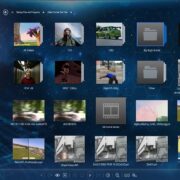Another great format war ended this week, with Blu-Ray to 70% of released films and, according to the Financial Times, HD-DVD left with one major studio. HD-DVD owners are either mildly put out, or happy they can now pick up HD movies for a few dollars as they’re tossed out by major retailers.
We’ve been here before: whether RealPlayer versus Windows Media, BSD versus Linux, or boxers versus briefs. Let’s take a look back at some of the great format wars of our time.
We should first clarify what we mean by losing. Losing a war doesn’t mean the technologies or formats are bad (though sometimes they are). This doesn’t mean the technologies aren’t in use either. It just means they’re no longer the default solution for their area. Every article on the death of ColdFusion was filled with angry developers pointing out new release of ColdFusion as an example of how alive the language was. But ColdFusion developers are scarce, it’s rarely chosen for new projects, and its no longer viewed as a mainstream web development language like PHP. ColdFusion lost the technology war. Deal with it.
Table of Contents
Metric versus Imperial
The war to end all wars. Until the 1960’s, imperial rocked the world, and students spent a great deal of time learning to convert fonoobularsers into schmeekulars. Since then, however, everywhere but Myanmar, Libya and, er, the USA have switched to metric, with unfortunate consequences for polar landers everywhere.
Winner: Metric
Loser: Polar landers
Word and WordPerfect
PCs were DOS, GUIs were for children, and WordPerfect was the wordprocessor.But then Windows came out, and due to a sweet combo deal for PC makers shipping MS-DOS, Windows 3 now came with most PCs. Sure, you could run WordPerfect for DOS, but Microsoft had a pretty damn good version of Word for Windows that could read WordPerfect files. Alas for WordPerfect, patenting file formats wasn’t invented back then, so WordPerfect had to stand on its own two rather smelly feet. By the time a decent GUI WordPerfect came out, nobody cared. A few years later, Microsoft bundled WinWord with its other.
Winner: Word
Netscare versus Internet Explorer In the mid 90’s years Netscape was the internet for a lot of people. Microsoft were still touting their (then proprietary, not internet based) MSN as the sensible alternative to the internet.
But then something changed. Bill Gates sent a memo to everyone in Microsoft about a coming Internet tidal wave. So in the late 90s and early noughties, Microsoft did everything they possibly could to better Netscape. Making their browser free, gluing the browser into the Windows file manager and desktop, and pleasing developers by pushing ahead with standards support that ate Netscape’s for breakfast.
Meanwhile, Netscape did everything to annoy it users. Netscape put a ’shop’ button next to ’stop’, and while having Open Sourced its code to create the Mozilla project, Netscape seemed to have missed the whole ‘release early, release often’ tenant of that movement – the company didn’t release a major new version of Netscape for 5 years after Netscape 4 shipped. In a forward war, Netscape apparently forgot to add ‘compete’ to its to-do list. IE market share went from 20% market share in 96 to 80% in 2000.
The winner: Internet Explorer.
RealPlayer and Windows Media Player
In the late 90s, a former Microsoft executive sees the internet coming, and starts creating a first-to-market streaming audio and video system that works on every platform, is free, included with the most popular web browser. The model is simple:charges companies for the authoring tools to create files, and provide a better version of the player to paid customers. Microsoft itself has no idea about the internet at the time and does not respond for years.
So why did RealPlayer lose? They did everything possible to annoy their customers. In 1999, the free player, hidden to this day in Real’s website, was pimped out to spyware companies like Comet Cursor. That same year the world realized the software sent a list of everything each user played back to RealNetworks. Meantime, the free player kept harassing you with popup advertisements, while you were using other software. Muting RealPlayer stopped all other sound applications from playing (a problem that persists to this day). During installation, RealPlayer asked if it could bone your sister, and if you unticked the box, it did it anyway. OK we made that last one up. We think.
Windows Media Player took advantage of Microsoft’s desktop monopoly to get onto everyone’s desktop, and stayed there because it didn’t suck.
Winner: Windows Mobile
DVD-RW and DVD+RW
Sure, there were vast technical differences, but nobody cared. In the early 2000s, most could burn either the DVD Forum backed DVD-RW (supported by Apple and Pioneer) or DVD+RW, supported by HP, Dell and Microsoft. DVD-RW cracked first, converting to Hybrid DVD+/-RW drives a couple of years before everyone else did.
The winner: +RW. But the victory didn’t last long.
Internet Explorer versus Firefox
By 2003 Netscape was dead. Without any good competition (apart from the great-but-still unpopular Opera) Internet Explorer hadn’t been updated in a couple of years, and Microsoft, having no need to attract developers, stopped caring about standards support. Sure, there was Mozilla, but it was an ugly, slow, bloated mess.
In 2003 Firefox was announced to the world with a two page spread in the New York Times. Firefox didn’t look like another web browser. It had a more minimal design: one toolbar, with only the basic navigation controls placed beside the location bar, and, handily tabs underneath.It was snappy and responsive, and the ability to block annoying flashing images and popup advertising were standard features. It also had great standard support.
In late 2006, five years after IE6, Internet Explorer 7 came out. Its has a more minimal design: one toolbar, with only the basic navigation controls placed beside the location bar, and, handily tabs underneath.It’s snappy and responsive, and the ability to block annoying flashing images and popup advertising are standard features. It also has improved standard support.
That wasn’t enough though: from 2004 to the present, Internet Explorer’s market share has been in slow, steady decline. While Firefox may only be around 20% of computer users worldwide, it’s clear which browser is setting the agenda for web browser development.
Winner: Firefox
Handheld Devices: Windows Mobile versus Palm
After Apple’s Newton failed to take off, Palm was first to popularize the PDA. Microsoft saw the opportunity, and came out with, er, Palm-Sized PCs, before getting their ass handed to them on a plate. Later rebranding to Windows CE and then Windows Mobile, Microsoft differentiated from Palm’s strictly-business devices by giving users color screens and multmedia support. The Windows Mobile applications didn’t share much code with their desktop counterparts – editing a document in Word Mobile still removes most of the formatting, and Pocket IE can’t show most websites properly – but the brand recognition were strong enough to sway users to Windows Mobile. Microsoft licensed their OS to all and sundry, and while HP came out with some great iPAQs, the cleverly namd High Tech Computer (now just HTC), emerged from obscurity with a variety of innovate devices to become the most popular maker of PDAs. Palm, meanwhile, did…not much at all.
Winner: Windows Mobile
Web Development: Microsoft Stack vs LAMP
Once upon a time, there was ASP. It was web development for VB coders back when VB was the easy choice for web apps, and merely required a license for a server platform with a spotty security record that needed to be restarted for every security update. But the market leading web server was generally deployed on Unix platforms, which already shipped PHP, and either MySQL or PostgreSQL, and had a better reputation for security and maintenance. Sure, ASP still exists, but it’s now a language for Microsoft-obsessed corporates, and virtually unheard of in the startup space. See for yourself what the current crop of web 2.0 sites use, then visit the Y Combinator news forums and realize nothing’s about to change.
Winner: LAMP
Open Source Desktops: GNOME and KDE
KDE was the older, more polished desktop. GNOME was a weird acronym, whose main features were being brown, having this icon, and changing its internals every five seconds (Enlightenment, Sawfish, Metacity, a plastic banana). GNOME got some traction because Red Hat and Debian didn’t like KDE’s reliance of QT, which would have required proprietary app developers to pay a licensing fee to Trolltech. This eventually changed, but meanwhile GNOME had started to improve – and become the basis for Evolution, one of the first mail clients on any platform to include bayesian filtering and smart folders. The major Open Source web browsers, Mozilla and then Firefox, also used the GTK theme to varying levels.
A few years later, Ubuntu was created from Debian. Fedora was created from Red Hat. Then SuSE brought GNOME boosters Ximian, and switched from GNOME to KDE as default. Now: the most popular Linux desktops, Ubuntu, Fedora and OpenSuSE, use GNOME by default. Meanwhile KDE spends its days convincing people that, er, 4.0 doesn’t mean 4.
Winner: GNOME
Open Source Operating Systems: BSD vs Linux
BSD took Unix, a popular proprietary operating system requiring proprietary hardware, and made it available for free on x86 under an Open Source license. It existed before Linux did, and for the first few years Linux came along, and was technically superior in many ways, with securelevels, dependency based packaging, fantastic firewalling, and good documentation, before these features (or their equivalents) existed for Linux.
The only think it lacked was by design: BSD was licensed to allow anybodyo do pretty much anything they want with it, including take the source code and improve it without releasing the improvements back. Folks loved the license, and took advantage of it – BSD’s networking code and IP utilities ended up in Windows NT, other utilities ended up in NetApp Filers, and a bunch of other embedded firewalls are based on the entire OS.
Today, lots of people use BSD code. They use it in proprietary applications, have no idea who created it, and have no idea that BSD exists as an Open Source general purpose operating system. Meanwhile, the GPL license of Linux attracted more developers, creating better software, in turn attracting more developers. Linux now does everything that was unique to BSD, a lot more it doesn’t.
Winner: BSD. Just kidding.
Windows Media Player and Flash Video
Windows Media Player trounced Real, and seemed unstoppable. Meanwhile, Flash – which, as an essential plugin, also came with Windows, along with the growing-in-popularity Firefox and OSX’s Safari, quietly added Sorenson Sparc video support. Suddenly Flash wasn’t just a plugin for animation and sound, but a video platform.
The timing was great. The web video scene was starting to expand rapidly, now that users finally had the connections to handle it. Flash was easier to update than Windows Media Player, and the quality was great – to the point Apple (who make the less popular Quicktime) sued Sorenson, the codec provider, claiming that Sorenson’s technologies were licensed exclusively to them. Subsequent updates added new and better codecs. The plugin updated itself, and after a couple of years Flash video support was everywhere.
In 2005 Youtube and Revver (and a plethora of wannabes) came along, basing their business models on the new format. In the last year, ever major video site has been based on Flash Video – and none on Windows Media.
Winner: Flash
Disagree? Think we’ve missed a format war? Really, really, like Realplayer, and your sister can date who she wants? Comments below as usual.




















Comments